OUR LADY OF ZAPOPAN, Guadalajara, Jalisco
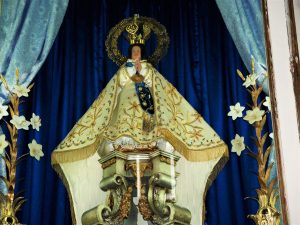
Last October 13, 2022, one subject dominated the headlines in most of the Catholic media world: Our Lady of Zapopan. The news outlets were reporting on the annual October 12th procession of the diminutive 16th century statue of Our Lady of Zapopan from the Guadalajara Cathedral to her own Basilica of Zapopan, a journey of about six miles. This tradition was awarded the Cultural Heritage of Humanity by UNESCO in 2018.
And the reader must surely be asking at this point: Why would such an event garner the headlines to this degree? What made this procession so note-worthy? After all, was it not just a simple procession in the Catholic manner?
It was because of this: the journalists were simply astounded by the number of participants involved. A “record-breaking” 2.4 million people attended the event. This figure was confirmed by state governor Enrique Alfaro who said it was the highest number of participants in its 288- year-old- history
I would wager that the citizens of Guadalajara, however, were probably not astounded by these numbers at all. They are familiar with this phenomenon although not quite in numbers of this magnitude. Even the secular media, surprisingly, pays attention to Our Lady of Zapopan’s annual procession. And how could they not? “About half the city of Guadalajara (the second largest city in the country) joins in the procession,” said one media outlet. One tourist guide said that the numbers were beyond belief while another said “the legendary image of Our Lady of Zapopan has enjoyed generations of popularity so enormous that it must be seen to be believed.” This is true. I have been there. The Oct. 13, 2005 issue of The Miami Herald reported that one million participated in the event in 2005.
Amid great pomp and pageantry she is escorted back to her home, the Franciscan Basilica of Our Lady of Zapopan, having travelled throughout the diocese of Guadalajara for the previous four months. She is accompanied by throngs of rejoicing pilgrims, Franciscan friars, honour guards, priests, nuns, military bands, charros (cowboys in traditional outfits), cyclists, Mariachi musicians, children’s choirs and Indian dancers in authentic costumes. Banners of Our Lady of Zapopan, Our Lady of Guadalupe, and The Sacred Heart of Jesus are everywhere. The air is filled with stirring hymns, endless rosaries and joyous shouts of “Viva Cristo Rey.” There are no diffident, half-hearted Catholics in this crowd! It is the Catholic faith on display in all its rich glory. And moving beyond words.
Most striking are the numbers of indigenous dancers. The Mural, Guadalajara’s Spanish-language newspaper reported that “16,000 Indian dancers” participated in the annual procession in 2008 (the year I attended). As I watched the spectacle, words of Dickens’ from Hard Times came to mind: “A blaze of splendor.” He could have been describing the befeathered Indian dancers at Zapopan! Splashes of colour on the move: fire-engine reds, brilliant blues, emerald greens, all in exquisitely embroidered and beaded costumes. A dazzling sight.
Also dazzling was the sound of the ankle “rattlers.” A sound I will never forget. The rattlers are made from the shells of nuts which have been partially filled with small pebbles; these shells are then sewn on to leather ankle bands, producing a swishing type of sound, k-poosh, k-poosh, k-poosh. A sound like no other, melodious and captivating. Like a giant army on its way to heaven. The dancers spend a year in training, rehearsing weekly, sometimes daily, until all is just right, each step perfect, to offer to their beloved Lady of Zapopan.
It all began with the Franciscans. In 1524 the first group of twelve Franciscan missionaries from Spain landed on the coast of Veracruz in central Mexico. In 1525 the second group arrived, this time in the western part of the country in the area known as Nueva Galicia (the present-day state of Jalisco, of which Guadalajara is the capital). Among this group was Fray Antonio Segovia who was one of the first evangelizers of the area. The kindly and ascetic Fray Antonio (who loved the Indians as his sons) had a deep devotion to Our Lady and would always travel on his missionary journeys with her tiny statue around his neck. He claimed that it was she who was the evangelizer, not himself.
One of her titles is La Pacificadora, “the one who makes peace.” How she achieved this title occurred in a wondrous manner on one memorable day in 1540: While Fray Antonio was preaching “luminous rays issued from the statue.” It was declared by all present that “they were more beautiful than the light of the sun.” So impressed (and startled!) were the Indians with this divine manifestation that they laid down their arms (they had been warring with the Spanish) and begged to be baptized. Six thousand were brought into the Catholic faith at this time. Since the earliest days the indigenous peoples of Gaudalajara have been devoted to Our Lady. It has remained the most Catholic of Mexican states: during the years of persecution of the church in the 1920’s, statistics revealed that the most number of martyrs came from Jalisco. Not surprising perhaps because the headquarters for the Cristeros (“those who fought a war for Christ”) was located in Guadalajara.
The image is made of pasta de Michoacan a type of cornstalk which has been mixed with glue, a substance ideal for crafting durable and lightweight statues. The 13” statue represents the Virgin Mary under her title of the Immaculate Conception. It has the honour of being the first image of the Virgin Mary to be venerated in the state of Jalisco.
Our Lady of Zapopan wears different costumes: for the October 12th procession she is dressed in her travelling outfit, “a medieval pilgrim’s cloak and a broad-brimmed hat, looking like one of the pilgrims in an early woodcut of Chaucer’s Canterbury Tales” according to Father Joseph Cassidy, author of Mexico: Land of Mary’s Wonders. She also carries a large satchel, for, as one writer said, “What lady can travel without her travel bag?” At other times she is seen wearing a gold-tasseled sash, indicating military rank, and carrying a “gold baston of command.” Military rank? A baston of command? For Our Lady? Well, yes: in 1821, Mexico’s “Year of Independence,” the government commissioned Our Lady of Zapopan to be “General of the Army and of the State.” At which time she was vested with the sash and the baton and also declared the Patroness of the state of Jalisco.
Many are the honours accorded to Our Lady of Zapopan: After reports of numerous miracles an ecclesiastical investigation in 1641 declared the image to be taumaturga which means “wonder-working.” Among the verified miracles were the curing of a blind man and the restoration of a dead child to life. Further investigations in 1731, 1732 and 1733 confirmed twenty-six more miracles.
The construction of the shrine to Our Lady of Zapopan was completed and then dedicated on Sept. 8, 1730. The miraculous image was placed above the main altar where it can be seen at the present day.
In 1919 the Vatican authorized the pontifical coronation of the image and she was crowned on Jan. 18, 1921 by the saintly and revered Archbishop of Guadalajara, Francisco Orozco y Jimenez.
In 1940 Pope Pius XII elevated the shrine of Zapopan to the status of a basilica. Another singular honour was the visit of that most Marian of popes, St. Pope John Paul II, to the Basilica of Zapopan in 1979. A statue of him on the Basilica grounds commemorates the event.
In September 1988 the Archbishop of Guadalajara, Don Juan Jesus Posadas O Campo proclaimed Our Lady of Zapopan the Patroness of the diocese of Guadalajara. He was elevated to the position of Cardinal by St. Pope John Paul ll in 1991. Shockingly, two years later, he was assassinated at the Guadalajara International Airport. He died “in a hail of gunfire.” A government inquiry stated that he was “caught in a shootout between rival cocaine cartels.” The much-loved Cardinal had been a vigorous and outspoken critic of the drug cartels and a staunch defender of the faith. His remains are in the crypt of the Guadalajara Cathedral. To this date his case is still unsolved.
Through the centuries Our Lady of Zapopan has protected her people of Guadalajara from misfortune of all kinds: In 1734 the city was struck by a terrible pestilence. The Most Reverend Gomez de Cervantes issued a decree, directing that the statue of Our Lady of Zapopan be brought to the various suburbs of the city. The civil and religious authorites noticed that, “upon taking the statue to every suburb the pestilence stopped immediately.” From then on she was declared Patroness of epidemics and thunderstorms as well (the city is known to experience some vicious thunderstorms during the rainy season). She is also, not surprisingly, the patron of travel agents!
In 1946 the water levels of nearby Lake Chapala dropped to drastic levels. At the beginning of 1956 the city “underwent an unbelievable shortage of water.” The whole city prayed for a miracle and the statue was taken in procession to the lake. After this visitation the waters once again rose to near-normal levels. The citizens of Guadalajara have never stopped thanking Our Lady of Zapopan for her care and protection through almost five centuries.
St. Pope John Paul II spoke these words during his time at the shrine of Zapopan: “This sanctuary of Zapopan is, in effect, a proof most palpable and consoling of the intense devotion that the Mexican people profess to the Virgin Immaculate.”
And they demonstrate this love with a most robust enthusiasm! Every October 12th.
PLEASE NOTE!!!!!! The name of this website has been changed to:
madonnasofmexico.com
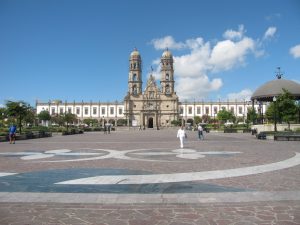
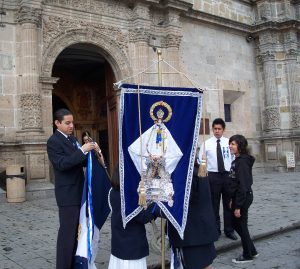


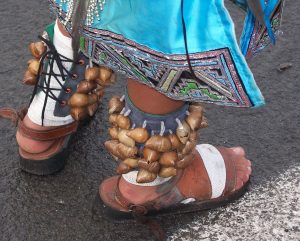
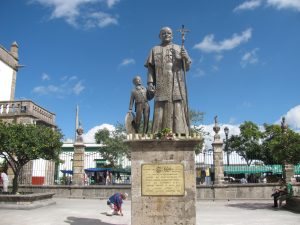

PLEASE NOTE!
The name of this website has been changed to:
mexicanmadonnas.com